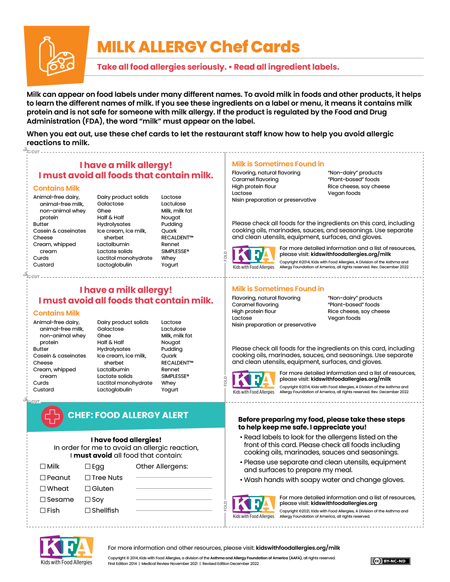Recipes & Diet

Replacing Milk
The following is a general guide to using ingredient substitutions for milk allergy. Please verify the ingredients and safety of any products named to make sure that it is safe for your child.
If you need additional help in finding product suggestions or where to find ingredients, post a message in the KFA Food and Cooking Support Forum to get suggestions from other parents who are also managing the same food allergies.
Basic Ingredient Substitutions for Food Allergies
Many common allergens are also common ingredients in your favorite recipes. There are some ingredients which can be easily substituted. There are others that may be more challenging. Whether or not a “safe” version of a recipe can be successfully made often depends on two important factors. First: what is the role of the ingredient in the recipe? Second: how many of the recipe’s ingredients require substitutions? If the recipe only has 5 ingredients and you need to swap out 4 of them, the end result might bear little resemblance to the original dish. The bottom line: sometimes you can create a “safe” version of a recipe, and sometimes you are better off finding a different recipe altogether.
Substitutes for Milk/Dairy Ingredients
Be aware that some brands and varieties of “non-dairy” products (especially soy cheeses) may contain casein (a milk protein) or are made in production facilities on equipment shared with dairy.
Substituting for Butter
One of the easiest substitutions to make is for butter: simply use a dairy-free margarine instead. However, you may need to do some searching and taste-testing to find the best dairy-free margarine available in your area, as a good margarine can make a big difference in many recipes. For baked goods, try to find a dairy-free margarine with a low water content and high fat content (e.g., stick of margarine usually contains less water than a tub of margarine). Margarines with high water content may affect your baked goods.
Substituting for Yogurt, Sour Cream, and Cream Cheese
Soy-based, coconut-based, and pea-based “yogurt,” “sour cream,” and “cream cheese” products are available. These generally work very well in recipes.
Substituting for Cheese
Dairy-free cheeses are a bit of a challenge. If a child is old enough to remember “real” cheese, you may want to wait a while before introducing a milk-free version. Younger children will usually adapt more easily. Soy cheeses do not taste or melt like traditional dairy cheeses. In some cases, soy cheese will not appear melted, but will in fact be melted inside. There are now milk-free and soy-free cheeses available from several brands. They are available in shreds, blocks and slices. These milk-free and soy-free cheeses also melt much better than milk-free cheeses of the past.
Milk-free cheese may not work well in recipes for cheese sauces. If you would like to make a dairy-free “cheese sauce,” check our Safe Eats® recipe database for “cheese sauce” recipes based on nutritional yeast.
Substituting for Milk
There are a number of commercially-produced cow’s milk alternatives made from soy, coconut, rice, potato, oat, almond, hazelnut, cashew, hemp, flax, sunflower, and even macadamia. Most of these are available in a few different flavors (such as “original,” “vanilla,” “chocolate,” and “mocha”). All of these milk beverages can be substituted 1-for-1 in recipes.
Note: Goat’s milk is not considered a safe alternative for people allergic to cow’s milk.
Alisa Fleming has done extensive taste-testing to determine which types of milks work best in which types of recipes. The following information is reprinted with permission from her book, “Dairy Free Made Easy” by Alisa Fleming of www.godairyfree.org:
SOY MILK
Taste:
- In general, soy milk is considered “hearty” among the non-dairy beverages, and is excellent when you are craving something thick and creamy.
- The plain varieties have a faintly sweet and nutty flavor.
- Taste and consistency vary widely among soy milk brands.
Uses:
- Soy milk can easily be substituted for cow’s milk in all baking needs, over cereal, for pancakes and waffles, in smoothies, or straight from the glass.
- The unsweetened varieties work equally well in savory dishes.
- Soy milk does have a more pronounced flavor, so it may not be the top choice for delicate desserts and sauces.
RICE MILK
Taste:
- For many, rice milk has that “true milk flavor.” It is one of the lightest, sweetest, and most refreshing of the dairy substitutes.
Uses:
- With its natural sweetness, rice milk is perfect in desserts and baked goods.
- Its delicate texture also works well in curries as well as lighter cream soups and sauces.
- Rice milk is best avoided in the broader savory foods arena.
OAT MILK
Taste:
- Oat milk is light in texture and has a very mild flavor with just a hint of sweetness. It substitutes very well for low-fat or fat-free milk.
Uses:
- Oat milk is a good substitute for cow’s milk in both sweet and savory dishes.
- In addition to drinking it straight from the glass, oat milk is recommended for your morning cereal; smoothies; baked goods; curries; lighter cream soups and sauces; and mashed potatoes.
Substituting for Sweetened Condensed Milk and Evaporated Milk
You can make your own sweetened condensed milk substitute by making a “safe” evaporated milk and adding sugar. Evaporated milk is milk that has water content reduced by 60%. Simmer any quantity of soy or rice milk in a pan until it reduced by 60% to get evaporated milk. Approximately 3 cups of rice or soy milk will leave 1 cup of evaporated milk left at the end. Be careful not to scald it. For sweetened condensed milk, mix one cup of evaporated milk with 1-1/4 cups of sugar. Heat until the sugar is completely dissolved. Cool. It will yield 1-1/2 cups of evaporated milk substitute. It will keep in the refrigerator for several days.
Another alternative for evaporated milk is to substitute coconut milk 1:1 in the recipe. This will impart a coconut flavor to the recipe, so it works in some recipes but not all. There are also commercially available sweetened condensed or evaporated milk alternatives.
Substituting for Buttermilk
You can make your own buttermilk substitute by mixing one tablespoon vinegar plus 1 cup milk alternative such as rice milk or soy milk.
Substituting for Light Cream, Sweet Cream, or Heavy Cream
Substitutes for light cream: light (or “lite”) canned coconut milk, soy creamer, coconut-based creamers, almond-based creamers
Full fat coconut milk can be substituted for heavy cream. A coconut milk substitute will impart a coconut flavor to a recipe, so it will work for some recipes, but not all.
Dairy-free whipped topping can be used as a substitute for sweet cream if used straight out of the carton and not whipped.
Updated December 2022.













